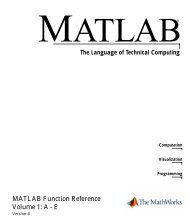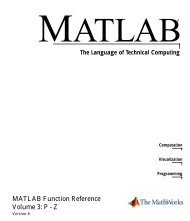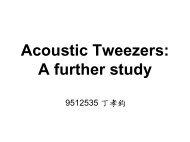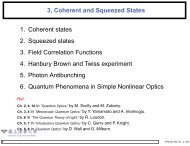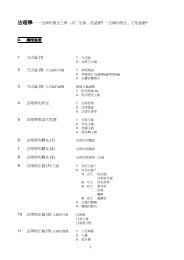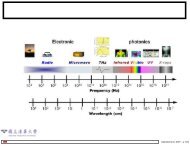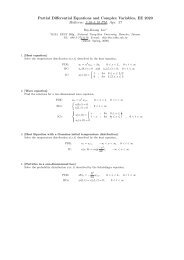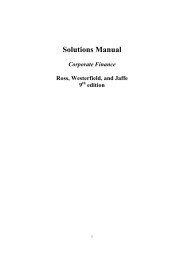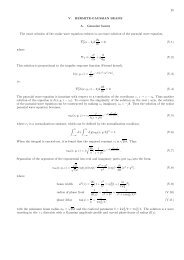Homework 3
Homework 3
Homework 3
You also want an ePaper? Increase the reach of your titles
YUMPU automatically turns print PDFs into web optimized ePapers that Google loves.
經濟學原理一<br />
ECON 100103 <strong>Homework</strong> 3 Due on 2011/11/29<br />
小組成員<br />
學號 _____________________ 姓名_____________________<br />
學號 _____________________ 姓名_____________________<br />
學號 _____________________ 姓名_____________________<br />
學號 _____________________ 姓名_____________________<br />
學號 _____________________ 姓名_____________________<br />
Section I. Multiple Choice Questions<br />
1. If there is pollution in producing a product, then the market equilibrium price<br />
A) is too high and equilibrium quantity is too low.<br />
B) and equilibrium quantity are too low.<br />
C) and equilibrium quantity are too high.<br />
D) is too low and equilibrium quantity is too high.<br />
Figure 1<br />
Figure 1 shows a market with an externality. The current market equilibrium output of Q1 is<br />
not the economically efficient output. The economically efficient output is Q2.<br />
2. Refer to Figure 1. Suppose the current market equilibrium output of Q1 is not the<br />
economically efficient output because of an externality. The economically efficient output is Q2.<br />
In that case, the diagram shows<br />
A) the effect of a positive externality in the production of a good.<br />
B) the effect of a negative externality in the production of a good.<br />
C) the effect of an external cost imposed on a producer.<br />
D) the effect of an external benefit such as a subsidy granted to consumers of a good.<br />
1
經濟學原理一<br />
ECON 100103 <strong>Homework</strong> 3 Due on 2011/11/29<br />
Figure 2<br />
3. Refer to Figure 2. Which of the following statements is true about the price elasticity of<br />
demand?<br />
A) The elasticity coefficient is constant along the demand curve.<br />
B) The elastic portion of a straight-line downward sloping demand curve corresponds to the<br />
segment above the midpoint.<br />
C) The inelastic portion of the demand curve corresponds to the segment above the midpoint.<br />
D) At the midpoint of the demand curve, the elasticity coefficient is zero.<br />
4. Refer to Figure 2. At the midpoint of the demand curve, in absolute value,<br />
A) the price elasticity coefficient is at a maximum.<br />
B) the price elasticity coefficient is at a minimum.<br />
C) the price elasticity coefficient is zero.<br />
D) the price elasticity coefficient is one.<br />
5. Consider the following characteristics:<br />
a. low transaction costs<br />
b. small levels of pollution<br />
c. high levels of pollution<br />
d. clear assignment of property rights.<br />
Which of the above are assumptions behind the Coase Theorem?<br />
A) a, b, and d<br />
B) a, c, and d<br />
C) a and d<br />
D) a only<br />
2
經濟學原理一<br />
ECON 100103 <strong>Homework</strong> 3 Due on 2011/11/29<br />
6. Sefronia and Bella share an apartment and they are deciding whether or not to purchase a<br />
weekly housecleaning service. The value of the service to each of them is $50 and it costs $80 to<br />
hire a housecleaner. Should they hire a housecleaner?<br />
A) Yes, if each contributes $50, then each stands to gain a consumer surplus.<br />
B) No, because each will wait for the other to hire the housecleaner.<br />
C) Yes, but only if a housecleaner will accept $50 so that each can take turns to pay the<br />
housecleaner.<br />
D) No, because it will be difficult for them to agree on which housecleaning service to use.<br />
7. Seth is a competitive body builder. He says he has to have his 12-oz package of protein<br />
powder to "feed his muscles" every day. On the basis of this information, what can you conclude<br />
about his price elasticity of demand for protein powder?<br />
A) It is elastic.<br />
B) It is perfectly elastic.<br />
C) It is perfectly inelastic.<br />
D) The price elasticity coefficient is 0.<br />
8. Jonah lives in a small town where there is only one Mexican restaurant. Which of the<br />
following is likely to be true about the price elasticity of demand for meals at the Mexican<br />
restaurant?<br />
A) Demand is likely to be perfectly inelastic.<br />
B) Demand is likely to be perfectly elastic.<br />
C) Demand is likely to be relatively elastic.<br />
D) Demand is likely to be relatively inelastic.<br />
9. Suppose a hurricane decreased the supply of oranges so that the price of oranges rose from<br />
$120 a ton to $180 a ton and quantity sold decreased from 800 tons to 240 tons. What is the<br />
absolute value of the price elasticity of demand?<br />
A) 0.11<br />
B) 0.37<br />
C) 2.69<br />
D) 9.33<br />
3
經濟學原理一<br />
ECON 100103 <strong>Homework</strong> 3 Due on 2011/11/29<br />
The publisher of a magazine gives his staff the following information:<br />
Current price $2.00 per issue<br />
Current sales 150,000 copies per month<br />
Current revenue $300,000 per month<br />
Current total costs $450,000 per month<br />
He tells the staff, "Our costs are currently $150,000 more than our revenues each month. I<br />
propose to eliminate this problem by raising the price of the magazine to $3.00 per issue. This<br />
will result in our revenue being exactly equal to our cost."<br />
10. Refer to Table above. Which of the following statements is correct?<br />
A) The publisher's analysis is correct only if the demand is perfectly elastic.<br />
B) The publisher's analysis is correct only if the demand is elastic.<br />
C) The publisher's analysis is correct only if the demand is perfectly inelastic.<br />
D) The publisher's analysis is correct only if the demand is unit-elastic.<br />
11. Facing stiff competition, Hendrix College, a small liberal arts institution in Conway, Ark.,<br />
decided two years ago to bolster its academic offerings, promising students at least three<br />
hands-on experiences outside the classroom, including research, internships and service projects.<br />
Although it raised tuition and fees by 29 percent, enrollment in the freshman class rose by 37<br />
percent.<br />
Source: Jonathan D. Glater and Alan Finder, "In New Twist on Tuition Game, Popularity Rises<br />
With the Price," New York Times, December 12, 2006<br />
Based on the information above, the demand for Hendrix College education is<br />
A) unit-elastic.<br />
B) perfectly elastic.<br />
C) relatively inelastic.<br />
D) More information is needed to answer the question.<br />
12. Consider a demand curve that has a constant elasticity value of 0. What happens to quantity<br />
demanded and total revenue when price increases?<br />
A) The quantity demanded and total revenue remain the same.<br />
B) The quantity demanded does not change but total revenue increases.<br />
C) The quantity demanded and total revenue fall to zero.<br />
D) The quantity demanded does not change but total revenue decreases.<br />
4
經濟學原理一<br />
ECON 100103 <strong>Homework</strong> 3 Due on 2011/11/29<br />
13. Suppose the California Nurses Union successfully secured a 12 percent increase in the wages<br />
of registered nurses. If a hospital responds by reducing the quantity of registered nurses hired<br />
and increasing the quantity of physician's assistants hired, what conclusion can you draw?<br />
A) Physician's assistants are more valuable in terms of their productivity.<br />
B) The price elasticity of demand for registered nurses is negative while the price elasticity of<br />
demand for physician's assistants is positive.<br />
C) The cross-price elasticity of demand between registered nurses and physician's assistants is<br />
positive.<br />
D) The cross-price elasticity of demand between registered nurses and physician's assistants is<br />
negative.<br />
14. Last year, Sefton purchased 60 pounds of potatoes to feed his family of five when his<br />
household income was $30,000. This year, his household income fell to $20,000 and Sefton<br />
purchased 80 pounds of potatoes. All else constant, Sefton's income elasticity of demand for<br />
potatoes is<br />
A) negative, so Sefton considers potatoes to be an inferior good.<br />
B) positive, so Sefton considers potatoes to be an inferior good.<br />
C) positive, so Sefton considers potatoes to be a normal good and a necessity.<br />
D) negative, so Sefton considers potatoes to be a normal good.<br />
15. An advantage of imposing a tax on the producer that generates pollution is that<br />
A) it forces the polluting producer to internalize the external cost of the pollution.<br />
B) the government can keep tabs on exactly what is produced in an industry.<br />
C) it will eliminate pollution.<br />
D) a producer can pass the cost of the pollution to consumers.<br />
5
經濟學原理一<br />
ECON 100103 <strong>Homework</strong> 3 Due on 2011/11/29<br />
Section II. Essay Questions<br />
(1) Are the cross-price elasticities of demand between the following pairs of products likely to be<br />
positive or negative? Briefly explain.<br />
a. Pepsi and Coca-Cola.<br />
b. French fries and ketchup.<br />
c. Steak and chicken.<br />
d. Blue-ray players and Blue-ray discs.<br />
6
經濟學原理一<br />
ECON 100103 <strong>Homework</strong> 3 Due on 2011/11/29<br />
(2) Use the following graph for Yolanda’s Frozen Yogurt Stand to answer the questions that<br />
follow.<br />
Price<br />
(dollars<br />
per cone)<br />
$3.00<br />
2.50<br />
0<br />
200<br />
A<br />
B<br />
225<br />
7<br />
C<br />
300<br />
D2<br />
D1<br />
Quantity (cones per day)<br />
a. Use the midpoint formula to calculate the price elasticity of demand for D1 between point A<br />
and point C and the price elasticity of demand for D2 between point A and point B. Which<br />
demand curve is more elastic, D1 or D2? Briefly explain.<br />
b. Suppose Yolanda is initially selling 200 cones per day at price of $3.00 per cone. If she cuts<br />
her price to 2.50 per cone and her demand curve is D1, what will be the change in her<br />
revenue? What will be the change in her revenue if her demand curve is D2?
經濟學原理一<br />
ECON 100103 <strong>Homework</strong> 3 Due on 2011/11/29<br />
(3)<br />
Number of<br />
Acres<br />
Deidre's<br />
Willingness<br />
to Pay<br />
(dollars)<br />
8<br />
Eugene's<br />
Willingness<br />
to Pay<br />
(dollars)<br />
Farhad's<br />
Willingness<br />
to Pay<br />
(dollars)<br />
1 $180 $140 $150<br />
2 160 130 130<br />
3 140 120 110<br />
4 120 110 90<br />
5 100 100 70<br />
6 80 90 50<br />
7 60 80 30<br />
8 40 70 20<br />
Table 1<br />
Price per<br />
Number of<br />
Acre<br />
Acres<br />
(dollars)<br />
1 $260<br />
2 280<br />
3 300<br />
4 320<br />
5 340<br />
6 360<br />
7 380<br />
8 400<br />
Table 2<br />
In an effort to maintain privacy and enhance property values, three homeowners, Deidre, Eugene<br />
and Farhad, are considering leasing a portion of adjoining vacant land for a private park. Table 1<br />
shows each person's willingness to pay for each quantity of the land. And suppose the landowner<br />
is willing to lease a portion of her land according to the following supply schedule given in Table<br />
2.<br />
a. Graph the marginal social benefit curve and the supply curve on the same diagram.<br />
b. What is the optimal quantity of land that homeowners should lease? Explain your answer.<br />
c. Briefly explain why a park of 5 acres is not optimal.



